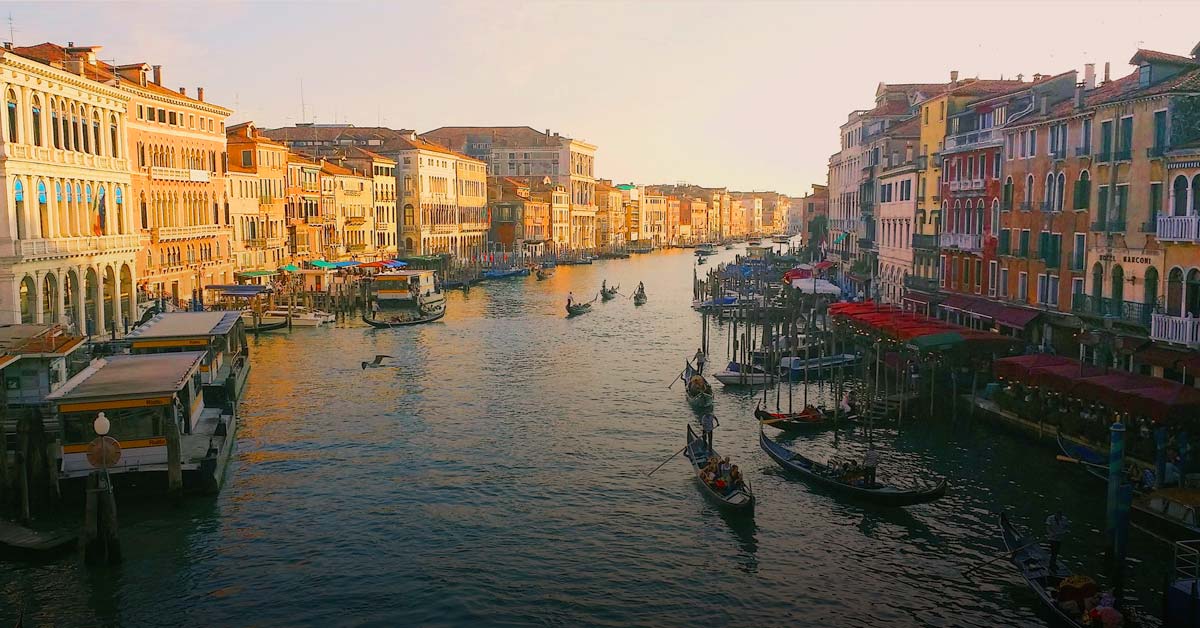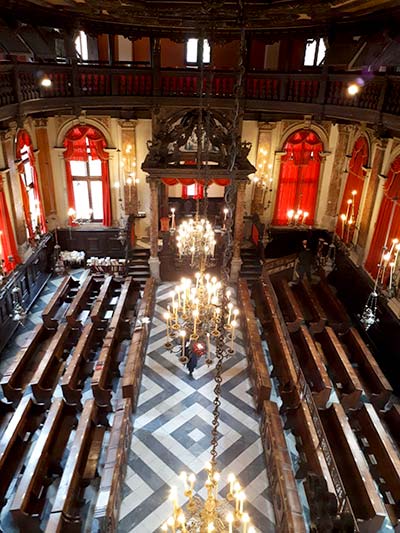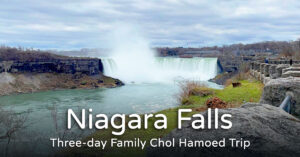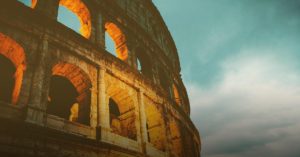It was late afternoon when we drove our tiny rental car into Portegrandi, a small, sleepy town by Venice. After a mad drive through pouring rain from Lake Garda we arrived at our cute B&B, which was above a rustic bar-restaurant.
The owner, charming Betty, welcomed us warmly. She had already hosted many Israelis in her Zimmer and told us that she had even visited the Sinai to dive.
We took the car to the closest train station, Quarto d’Altino, 8 minutes away from the B&B. we parked at the train station (it’s free) and took a 20-minute train to Venice.
We got off at Santa Lucia – Venice’s central station. We existed the platform and met the city—so familiar from photos and yet even more lovely in reality—face to face for the first time. We made our way directly to the impressive bridge across from the station, Scalzi Bridge. Squeezing among the multitudes of tourists and peddlers, we observed the magical view of Venice.
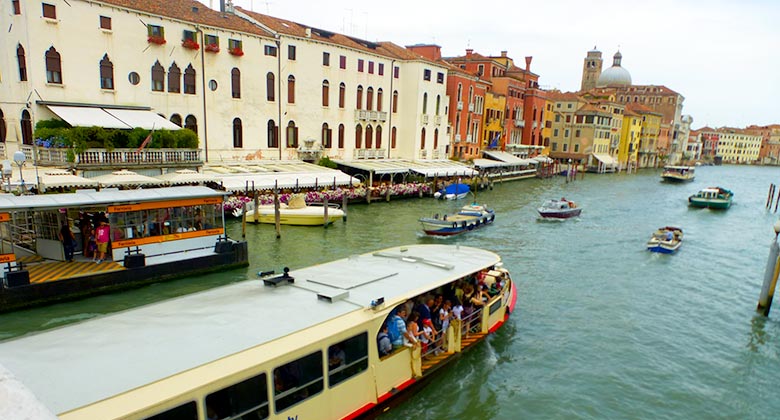
From there we made our way to the Venetian Ghetto. We passed through the picturesque alleys and crossed the old bridges over the canals. After a short while we remembered we were hungry and went to “Gam Gam” kosher restaurant, located by a canal at the Ghetto’s entrance.

We had a romantic dinner by the banks of the canal. The magical twilight atmosphere over the ancient houses on the water, along with the excellent food, made for a charming, unforgettable experience. We had spaghetti bolognaise, chicken cutlet, and fish. The food was delicious, and the server was personable. The fact that the restaurant wasn’t busy at that hour may have contributed to the experience.
When we finished our meal, we continued walking through the beautiful city. Outside it was getting dark, and we strolled through the narrow streets, softly and mysteriously lit by streetlamps. On every corner we ran into pasta or ice cream shops (a real torture for those observing Kosher), and storefronts laden with Venetian masks.
Along the way we even found an alley so narrow, its width was less than one meter! We took pictures at every corner and made our way toward the Rialto Bridge. At some point we realized the hour was late; we were afraid of missing the last train, and so we made our way back.
At the Venice train station, we had trouble purchasing our tickets at the automatic machine (the ticket windows were already closed at that hour). Luckily, a nice Belgian businessman standing behind us in line, helped us with the task. We struck up a conversation and he asked where we were from. When we answered that we arrived from Israel he told us he had visited – what a small world!
We rode the train for about a half hour, and from there drove through a completely dark road (which was a little stressful) all the way to Portegrandi. We arrived at our B&B happy and exhausted at midnight.
Next morning, we woke up early. We didn’t touch Betty’s homemade breakfast due to Kosher restrictions; we drank a cup of coffee and headed out. Again, we drove to the train station and from there to Venice. We got off at the central station and made our way directly to the Ghetto, to grab a bite to eat.
At the Ghetto we were pleased to find a kosher bakery. We ate a pizza there (after all, we were hungry) and bought pastries, cheeses, and sausage for the rest of the day. From there we proceeded toward the Spanish Synagogue. The Synagogue, built in 1580 by refugees of the Alhambra Decree, is the largest of the six synagogues in Venice.
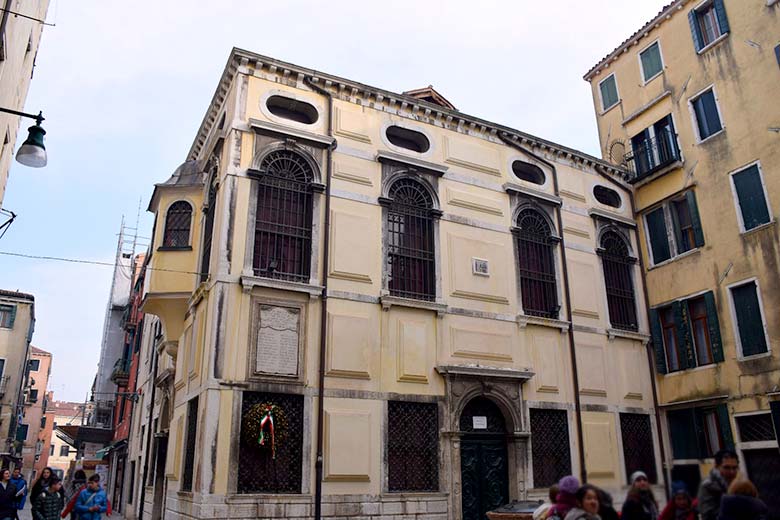
The synagogue’s hall is adorned with gold plated wooden filigree and is lit by three chandeliers made of Murano glass. The windows are covered in red curtains—a color signifying importance in Venice. A few steps away lies the Levantine Synagogue. On winter Saturdays the Levantine Synagogue is open since it is smaller and has heating, and on summer Saturdays the Spanish synagogue, which is cooler, is open in turn.
Only during one day of the year, Yom Kippur, are both synagogues open simultaneously. Those with a Levantine family will never pray at the Spanish Synagogue on Yom Kippur and vice versa. When there is a “mixed” marriage, each side will pray at the same synagogue their ancestors did!
When we arrived, the synagogue was unfortunately closed, and we could not wait for an organized tour of the place to begin. We took a picture outside and continued to wander the streets of the Jewish Venetian Ghetto, which exists since the 16th century and is one of the oldest ghettos in the world. Signs bearing old Hebrew writings can be seen in the alleyways.
It is well worth knowing that the term Ghetto, used to describe a Jewish residential area, is derived from the Italian name of the district, where it was located near a foundry (getto in Italian).
In the Ghetto’s center lies a large square with an ancient well at its center. An image of a lion is etched onto the well’s surface, symbolizing the tribe of Judah (not the San Marco lion). Additionally, a wall stands in the square, featuring copper engravings memorializing the Jews of Venice who died in the Holocaust.
The Jewish Museum of Venice is nearby and offers an organized tour (in English and Italian) of the synagogues included with admission.
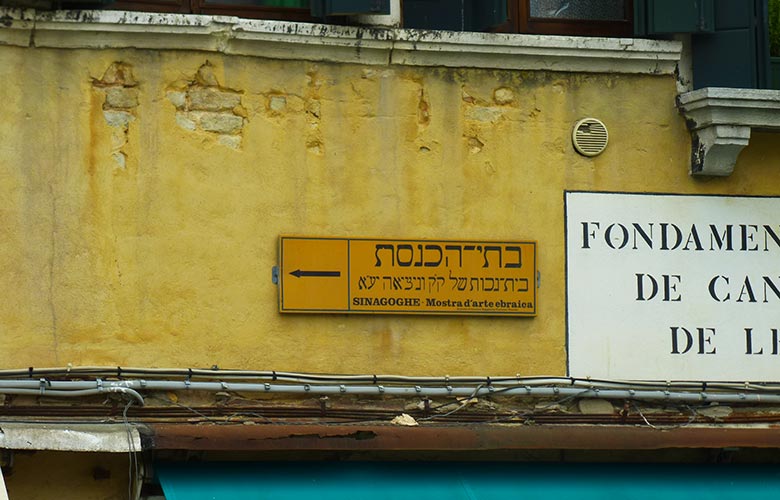
We decided to continue to San Marco Square (Piazza San Marco), which we didn’t have time to see the day before. The outrageous price of a gondola ride (around 100 Euros) made us forego a romantic gondola ride. I didn’t know there was a shared gondola ride option (up to 6 passengers) which lasts 30 minutes at a much cheaper price: only €32 per person!
To order a classic gondola ride at a reduced price >
We purchased a daily hop-on hop-off ticket and boarded the Vaporetto (a kind of waterbus). The ride, which began as a pleasant experience, became irritating due to its slow speed.
We got off at the famous San Marco Square. The square was scorching hot at noon and appeared less photogenic than at sunset, but was still very impressive, from the column with the winged lion atop it (the symbol of Venice) to the buildings of unique architecture surrounding it.
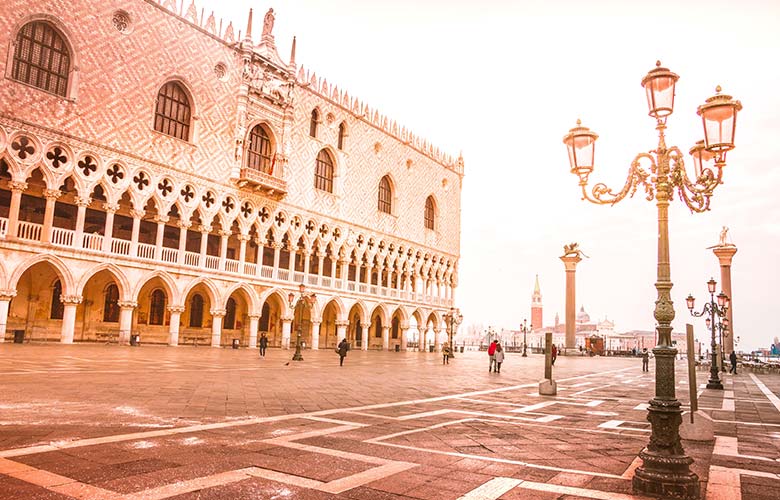
San Marco is considered one of Europe’s most beautiful squares and is in fact made up of two plazas. The larger is called Piazza San Marco, and the smaller, sea-facing one, is known as Piazzetta San Marco. There is an additional square on the plaza’s northeast side, Piazzetta dei Leoni, or “the small plaza of lions” named after its lion statuary.
The Doge’s Palace is connected to the Old Prison by the Bridge of Sighs. The bridge, built in the 16th century, is made of stone and creates an enclosed corridor between the two structures. The prisoners who were sentenced in the Doge’s Palace were led through the bridge into the windowless prison, getting their final glimpse of the outside world through the barred windows, giving the bridge its name.
In the square is located the St. Mark’s Basilica and the St. Mark’s Bell Tower. Surrounding the plaza are intricate buildings, such as Correr Museum and the Archeological Museum, and the beautiful, ancient Clock Tower. All over, in every corner, pigeons flock around tourists who feed them.
The Piazzetta di San Marco faces the sea, and at its forefront stands a carved pillar with the winged lion atop it—the symbol of the city of Venice. The Doge’s Palace, built in Venetian Gothic style, used to be the ducal residence, as well as a political and governmental center. The Palace is open to the public and has an art collection on display. You can book your tickets to the Palace here >
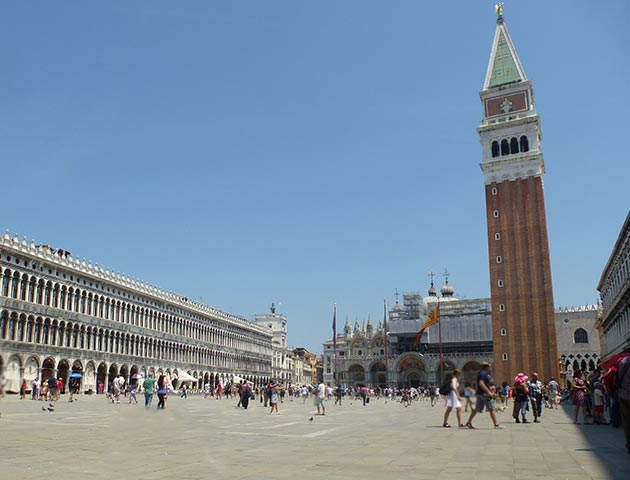
We decided to skip the long line to enter the Clock Tower and contented ourselves with admiring its façade. I also (regretfully) gave up on visiting the Doge’s Palace, since my husband showed no interest in going.
Suddenly the was a commotion in the square. Turns out we were lucky enough to be present during an impressive musical performance by a military orchestra. We found a good viewing spot and enjoyed every minute.
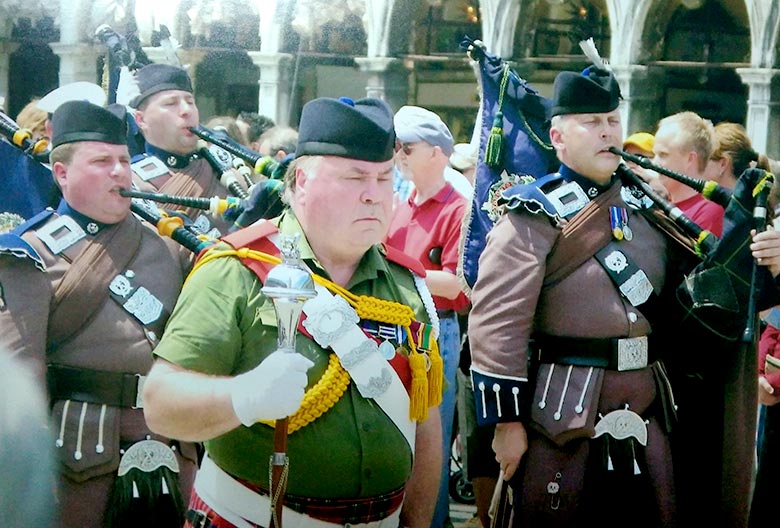
We continued from the square to Fonte Nove station. We got a little lost along the way, but not to worry; we asked tourists and locals and found the station eventually, where we embarked a ferry sailing to the Murano and Burano islands. In hindsight, we could have taken the ferry to the islands from a station adjacent San Marco. The ride would have taken about an hour, but with less chances of getting lost.
We sailed for about 15 minutes to the first island, Murano, also nicknamed “island of glass”. Murano glass is renowned for its beauty. We were welcomed by a beautiful glass sculpture of a bonfire, in all its fiery colors. We enjoyed looking at the different glass art exhibited around the island and in its shops.
We walked into one of the many glass-blowing workshops around and watched a live demonstration of a beautiful glass dish. The island is chock-full of stores offering an immense variety of glass products; from ornamental dishes, through chandeliers and lighting fixtures, to jewelry.
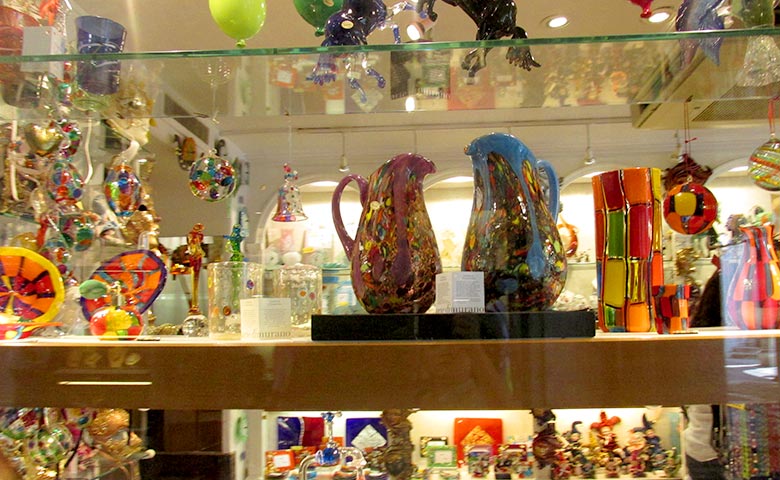
We continued with the ferry to the second island, Burano. It is a small, magical, colorful island, best described as picturesque. Colorful houses adorned with flower boxes, wooden bridges over water channels; rare beauty. We found a small grove and had a picnic lunch: baguette, cheese, some fruit, serenity, and the view; what more does a person need?
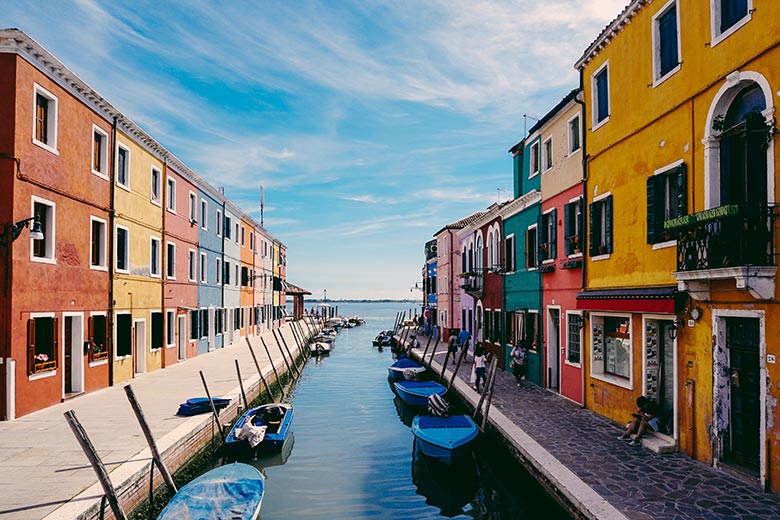
When we took the ferry back from Burano it had started to rain. The weather in Venice is fickle and surprising; we were suffering from the heavy heat at noon, and here, it was already raining come evening time!
After a beautiful and busy day in Venice we returned to our home base of Portograndi.
Farewell Venice, we saw quite a lot during our one-day visit, and we will return to it with the kids, on a Saturday. A totally different and unique experience.
Synagogues in Venice
Venice is home to 6 synagogues today – the Ashkenazi, the Spanish Synagogue, the Levantine, the Italian, Chabad, and the Canton Synagogue. Each one is more lovely and special than the other, and they all have one thing in common:
The Bimah (platform) is on the western side of the synagogue, and the Torah ark on the opposite, eastern side (unlike other synagogues around the world, where the platform is in the center). The reason is that Venice is sinking, and the opposite locations of the Bimah and ark are meant to disperse the weight across the space more evenly.
The Spanish Synagogue – The largest and grandest of them all. Alternately open with the adjacent Levantine Synagogue, and therefore only open during summer Saturdays, between Passover and Sukkot.
Paid tours are held during the weekdays, in collaboration with The Jewish Museum of Venice. Admission on Saturdays is for worshipers only. Tourists must present their passports (you should arrive at the house of the Jewish community with your passport on Friday, in order to get details and directions for the Saturday prayer). The prayer is beautiful and special, and at its end the worshipers are invited to a lavish Kiddush in the adjacent hall.
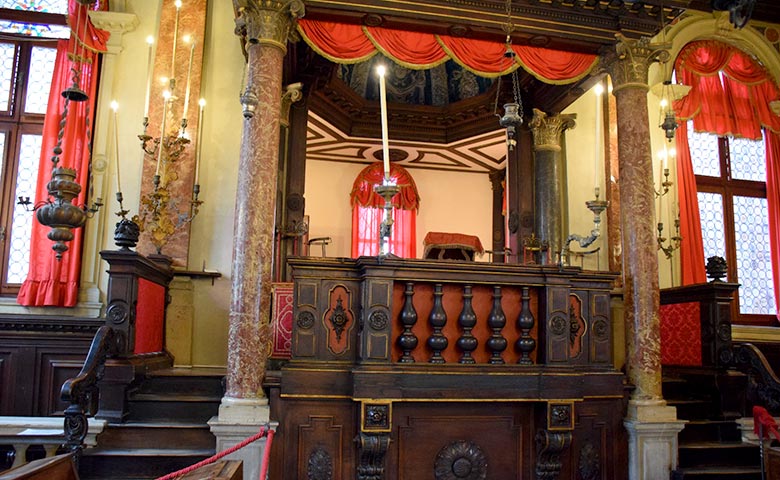
The Levantine Synagogue – Was founded in 1541 and rebuilt in the second half of the 17th century. It is located near The Sephardic Synagogue. It is active during the winter Saturdays, since it is smaller than its Sephardic counterpart, and has heating. In the summer, The Sephardic Synagogue is active, due to its cooler temperature.
The Ashkenazi Synagogue – This is the Ghetto’s first synagogue, built in 1528 for the Ashkenazi congregation. It was renovated during the late Baroque period, while in the early 19th century balancing issues caused the moving of the Bimah across from the Torah ark so as not to overburden the floor. The unusual design of the synagogue was done in harmony with its elliptical ladies’ section, and its walls are covered in golden decorations, and the ten commandments, written in golden letters over a red background.
The Canton Synagogue – Was founded in 1531/32 and was completely renovated during the late Baroque period. A small yet special synagogue with spectacular illustrations.
The Italian Synagogue – Was founded in 1575 and is the plainest of the Venetian Synagogues. At least this is the most well-lit Synagogue, thanks to five wide windows that open to the south side of the square. It is also the strictest of the synagogues, due to the absence of golden decorations which adorn its Ashkenazi counterparts.
The Chabad Synagogue—A simple and functional synagogue; a classic, warm, and friendly Shtiebel.
Do you also want to travel independently and kosher?
Join thousands of other travelers, and receive straight to the email the most comprehensive and practical articles for observant travelers abroad.
Sign up here:
מלונות כשרים בונציה בעברית: מלונות מתאימים לשומרי כשרות ושבת בונציה, מלונות ודירות מומלצים ליד בית חב”ד ונציה ועוד תוכלו למצוא באתר מטיילים בכיפה

